Effect of Foliar Application of Micronutrients and Fungicides on the Nitrogen Use Efficiency in Winter Wheat
Abstract
:1. Introduction
2. Materials and Methods
2.1. Experimental Setup
2.2. Experimental Design
- Three systems of wheat foliar protection in the spring part of the growing season (FP):
- 1.1.
- N + foliar fertilization with macronutrients (N + Mi, fungicide control − FC)
- 1.2.
- N + fungicide protection (N + P);
- 1.3.
- N + micronutrients + fungicide protection (N + Mi + P).
- Seven rates of applied fertilizer N: 0, 40, 80, 120, 160, 200, 240 kg ha−1.
- (1)
- 80 kg N ha−1—the late winter, before beginning of winter wheat vegetation in spring;
- (2)
- 160 kg N ha−1—at the end of tillering/beginning of shoot elongation (BBCH 29/30);
- (3)
- 240 kg N ha−1—at the stage of a flag leaf becoming visible (BBCH 39).
2.3. Plant Sampling
2.4. Calculated Parameters
2.4.1. Regression Models
- 1.
- Linear:
- 2.
- Quadratic:
- GY—grain yield, t ha−1;
- GN—N accumulated in grain, kg ha−1;
- TN—N accumulated in total wheat biomass, kg ha−1;
- Nfi—“i” dose of fertilizer N, kg ha−1;
- Nop—optimal N rate, kg ha−1;
- GYmax—maximum GY for the Nop, t ha−1;
- A, B, C, a, b, c—constants of the respective regression model.
2.4.2. Parameters and Indices of Nitrogen Use Efficiency (NUE)
- 1.
- Nitrogen accumulating in wheat grain, GN
- 2.
- Nitrogen accumulating in harvest residues, Nr
- 3.
- Total accumulating nitrogen in wheat biomass, TN
- 4.
- Nitrogen Harvest Index, NHI [44]
- 5.
- Nitrogen Unit Accumulation, NUA [44]
- 6.
- Nitrogen Unit Productivity-Grain, NUP-G [44]
- 7.
- Nitrogen Unit Productivity-Total, NUP-T [44]
- 8.
- 9.
- Nitrogen Agronomic Efficiency, NAE [45]
- 10.
- Nitrogen Recovery, N-R [45]
- 11.
- Nitrogen Physiological Efficiency, NPhE [45]
- NHI—nitrogen harvest index, %;
- HR—harvest residues, t ha−1
- Nc—nitrogen control.
2.5. Statistical Analysis
3. Results
3.1. Grain Yield and Grain Yield Structure
- (1)
- progressive:
- (2)
- smooth:
- (1)
- N + P:
- (2)
- N + P + Mi:
3.2. Nitrogen Accumulation
3.3. Nitrogen Efficiency Indices
4. Discussion
4.1. Grain Yield and Components of Yield Structure
4.2. Agronomic Measures and Nitrogen Use Efficiency (NUE)
5. Conclusions
Author Contributions
Funding
Data Availability Statement
Conflicts of Interest
Appendix A
| Traits | YS | TB | HI | ED | GE | GD | TGW |
|---|---|---|---|---|---|---|---|
| YG 1 | 0.83 *** | 0.97 *** | 0.84 *** | 0.89 *** | 0.91 *** | 0.99 *** | 0.59 ** |
| YS | 1.00 | 0.94 *** | 0.41 | 0.96 *** | 0.64 ** | 0.87 *** | 0.30 |
| TB | 1.00 | 0.69 ** | 0.96 *** | 0.84 *** | 0.98 *** | 0.49 * | |
| HI | 1.00 | 0.52 * | 0.90 *** | 0.79 *** | 0.71 *** | ||
| ED | 1.00 | 0.67 ** | 0.91 *** | 0.35 | |||
| GE | 1.00 | 0.91 *** | 0.51 * | ||||
| GD | 1.00 | 0.47 * |
| Traits | Nr | NT | NHI | NUA | NUP-G | NUP-T | ED | GE | GD | TGW |
|---|---|---|---|---|---|---|---|---|---|---|
| NG | 0.74 *** | 0.99 *** | 0.34 | 0.22 | −0.48 * | −0.31 | 0.90 *** | 0.67 ** | 0.85 *** | 0.45 * |
| Nr | 1.00 | 0.83 *** | −0.36 | 0.75 *** | −0.83 *** | −0.79 *** | 0.61 ** | 0.06 | 0.34 | 0.63 ** |
| NT | 1.00 | 0.20 | 0.36 | −0.59 ** | −0.44 * | 0.87 *** | 0.56 ** | 0.77 *** | 0.51 * | |
| NHI | 1.00 | −0.72 *** | 0.49 * | 0.70 *** | 0.33 | 0.86 *** | 0.68 ** | −0.20 | ||
| NUA | 1.00 | −0.95 *** | −0.99 *** | 0.07 | −0.51 * | −0.29 | 0.34 | |||
| NJP-G | 1.00 | 0.97 *** | −0.31 | 0.24 | 0.01 | −0.32 | ||||
| NJP-T | 1.00 | −0.19 | 0.44 | 0.19 | −0.33 |
| Traits | NAE | R-N | N-FF | ED | GE | GD | TGW |
|---|---|---|---|---|---|---|---|
| PFP-N 1 | 0.96 *** | 0.92 *** | 0.70 ** | −0.79 *** | −0.56 * | −0.80 *** | −0.11 |
| NAE | 1.00 | 0.93 *** | 0.82 *** | −0.81 *** | −0.39 | −0.70 ** | −0.02 |
| R-N | 1.00 | 0.60 ** | −0.84 *** | −0.42 | −0.73 ** | −0.14 | |
| N-FF | 1.00 | −0.54 * | −0.14 | −0.41 | 0.18 |
Appendix B
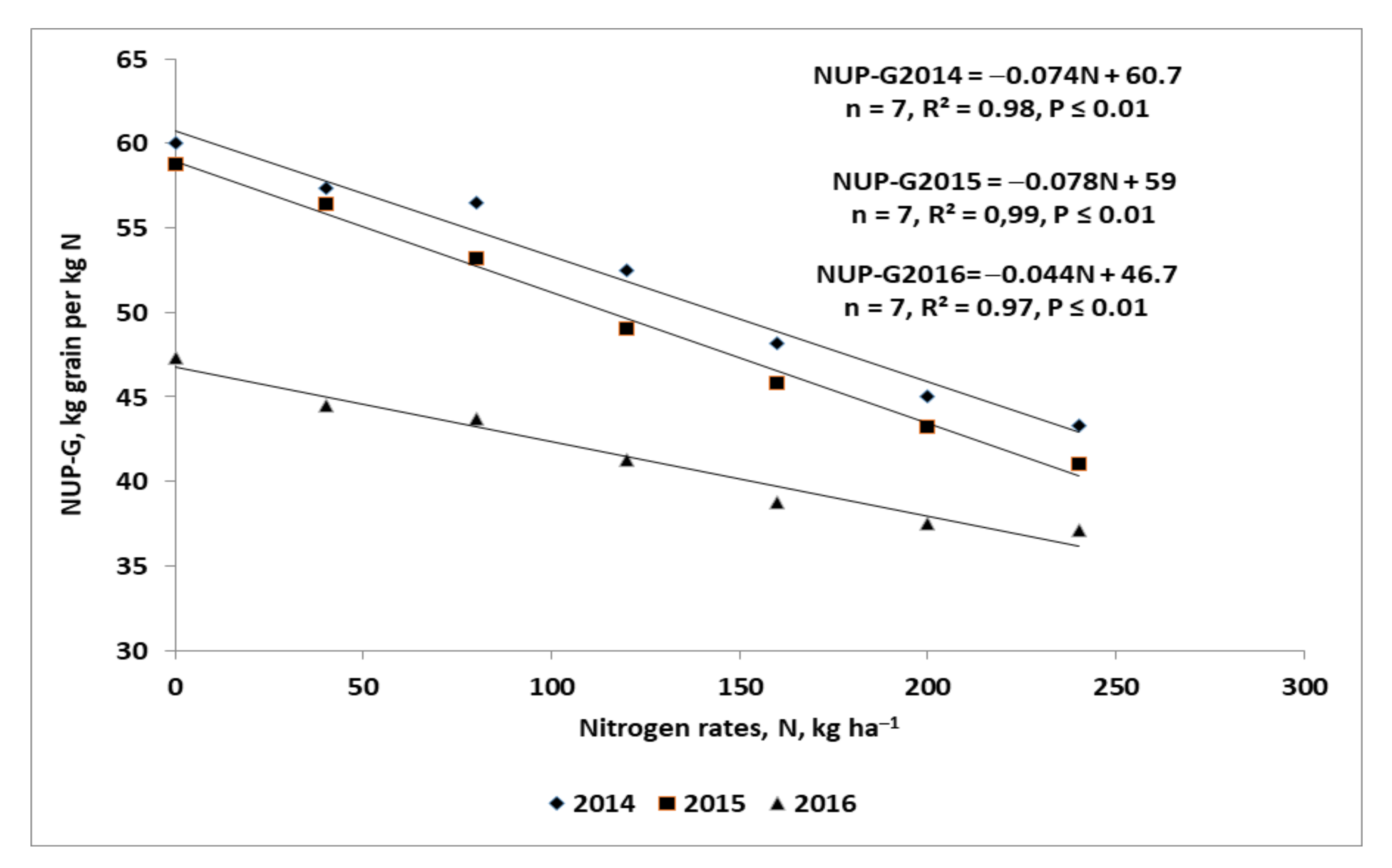
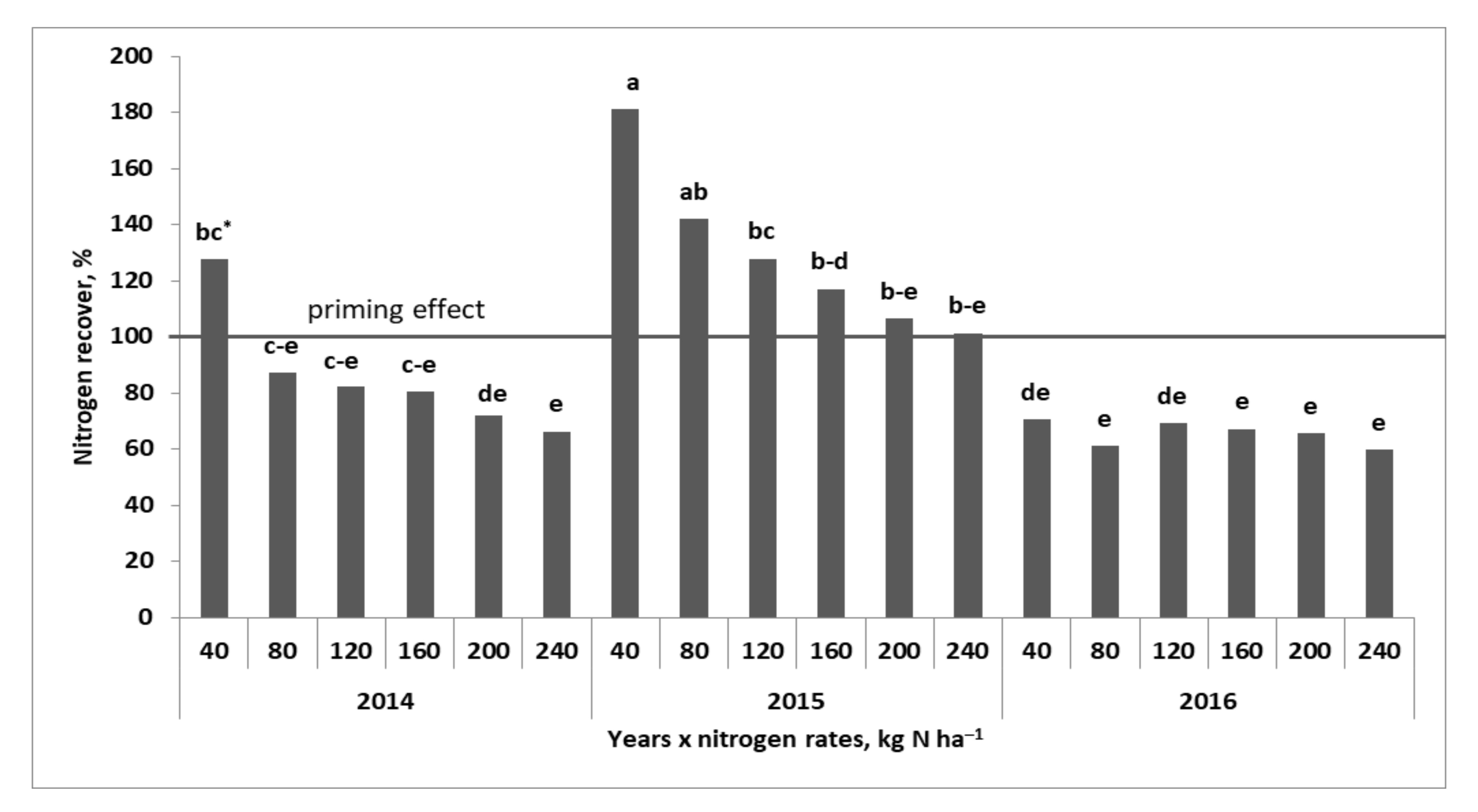
References
- Billen, G.; Lassaletta, L.; Garnier, J. A biochemical view of the global agro-food system: Nitrogen flows associated with protein production, consumption and trade. Glob. Food Sec. 2014, 3, 209–219. [Google Scholar] [CrossRef]
- Licker, R.; Johnston, M.; Foley, J.A. Mind the gap: How do climate and agricultural management explain the “yield gap” of croplands around the world? Glob. Ecol. Biogeogr. 2010, 19, 769–782. [Google Scholar] [CrossRef]
- Iwańska, M.; Paderewski, J.; Stępień, M.; Rodrigues, P.C. Adaptation of winter wheat cultivars to different environments: A case study in Poland. Agronomy 2020, 10, 632. [Google Scholar] [CrossRef]
- Jones, D.L.; Cross, P.; Withers, P.J.; DeLuca, T.H.; Robinson, D.A.; Quilliam, R.S.; Harris, I.M.; Chadwick, D.R.; Edwards-Jones, G. Nutrient stripping: The global disparity between food security and soil nutrient stocks. J. Appl. Ecol. 2013, 50, 851–862. [Google Scholar] [CrossRef]
- Schjoerring, J.K.; Cakmak, I.; White, P.J. Plant nutrition and soil fertility: Synergies for acquarring global green growth and sustainable management. Plant Soil 2019, 434, 1–6. [Google Scholar] [CrossRef] [Green Version]
- Schauberger, B.; Ben-Ari, T.; Makowski, D.; Kato, T.; Kato, H.; Ciais, P. Yield trends, variability and stagnation analysis of major crops in France over more than a century. Sci. Rep. 2018, 8, 16865. [Google Scholar] [CrossRef]
- Sinclair, T.R.; Rufty, T.W. Nitrogen and water resources commonly limit crop yield increases, not necessarily plant genetics. Glob. Food Sec. 2012, 1, 94–98. [Google Scholar] [CrossRef]
- Grafton, R.Q.; Williams, J.; Jiang, Q. Food and water gaps to 2050: Preliminary results from the global food and water systems (GFWS) platform. Food Sec. 2015, 7, 209–220. [Google Scholar] [CrossRef] [Green Version]
- McGuire, A.M.; Bryant, D.C.; Denison, R.F. Wheat yields, nitrogen uptake, and soil moisture following winter legume cover crop vs. Fallow. Agron. J. 1998, 90, 404–410. [Google Scholar] [CrossRef] [Green Version]
- Sylvester-Bradley, R.; Lunn, G.; Foulkes, J.; Shearman, V.; Spink, J.; Ingram, J. Management Strategies for Yield of Cereals and Oilseed Rape. HGCA Conference: Agronomic Intelligence: The Basis for Profitable Production. HGCA, 18. Available online: www.hgca.com/publications (accessed on 14 November 2021).
- Mayer, U. BBCH Monograph. In Growth Stages of Mono- and Dicotyledonous Plants, 2nd ed.; Federal Biological Research Center for Agriculture and Forestry: Berlin, Germany, 2001; Available online: http://www.jki.bund.de/fileadmin/dam_uploads/_veroeff/bbch/BBCH-Skala_Englisch.pdf (accessed on 14 November 2021).
- Tilley, M.S.; Heiniger, R.W.; Crozier, C.R. Tiller initiation and its effect on yield and yield components in winter wheat. Agron. J. 2019, 111, 1323–1332. [Google Scholar] [CrossRef] [Green Version]
- Meng, Q.; Yue, S.; Chen, X.; Cui, Z.; Ye, Y.; Ma, W.; Tong, Y.; Zhang, F. Understanding dry matter and nitrogen accumulation with time-course for high-yielding wheat production in China. PLoS ONE 2013, 8, e68783. [Google Scholar] [CrossRef] [Green Version]
- Bindraban, P.S.; Dimkpa, C.; Nagarajan, L.; Roy, A.; Rabbinge, R. Revisiting fertilisers and fertilization strategies for improved nutrient uptake by plants. Boil. Fertil. Soils 2015, 51, 897–911. [Google Scholar] [CrossRef] [Green Version]
- Hodgkinson, L.; Dodd, I.C.; Binley, A.; Ashton, R.W.; White, R.P.; Watts, C.W.; Whalley, W.R. Root growth in field grown winter wheat: Some effects of soil conditions, season and genotype. Eur. J. Agron. 2017, 91, 74–83. [Google Scholar] [CrossRef] [PubMed]
- Klepper, B.; Rickman, R.W.; Waldman, S.; Chevalier, P. The physiological life cycle of wheat: Its use in breeding and crop management. Euphytica 1998, 100, 341–347. [Google Scholar] [CrossRef]
- Kong, L.G.; Xie, Y.; Hu, L.; Feng, B.; Li, S.D. Remobilization of vegetative nitrogen to developing grain in wheat (Triticum aestivum L.). Field Crops Res. 2016, 196, 134–144. [Google Scholar] [CrossRef]
- Van Noordwijk, M.; van de Geijn, C. Root, shoot and soil parameters required for process-oriented models of crop growth limited by water or nutrients. Plant Soil 1996, 183, 1–25. [Google Scholar] [CrossRef]
- Forde, B.; Lorenzo, H. The nutritional control of root development. Plant Soil 2001, 232, 51–68. [Google Scholar] [CrossRef]
- Barraclough, P.B. The growth and activity of winter wheat roots in the field: Nutrient uptakes of high-yielding crops. J. Agric. Sci. Camb. 1986, 106, 45–52. [Google Scholar] [CrossRef]
- Shearman, V.J.; Sylvester-Bradley, R.; Scott, R.K.; Foulkes, M.J. Physiological processes associated with wheat yield progress in the UK. Crop. Sci. 2005, 45, 175–185. [Google Scholar]
- Slafer, G.A.; Elia, M.; Savin, R.; Garcia, G.A.; Terrile, I.I.; Ferrante, A.; Miralles, D.J.; González, F.G. Fruiting efficiency: An alternative trait to further rise in wheat yield. Food Energy Sec. 2015, 4, 92–109. [Google Scholar] [CrossRef]
- Johnston, A.M.; Bruulsema, T.W. 4R nutrient stewardship for improved nutrient use efficiency. Procedia Eng. 2014, 83, 365–370. [Google Scholar] [CrossRef] [Green Version]
- Olfs, H.-W.; Blankenau, K.; Brentrup, F.; Jasper, J.; Link, A.; Lammel, J. Soil-and plant-based nitrogen-fertilizer recommendations in arable farming. J. Plant. Nutr. Soil Sci. 2005, 168, 414–431. [Google Scholar] [CrossRef]
- Barłóg, P.; Łukowiak, R.; Grzebisz, W. Predicting the content of soil mineral nitrogen based on the content of calcium chloride-extractable nutrients. J. Plant. Nutr. Soil Sci. 2017, 180, 624–635. [Google Scholar] [CrossRef]
- Kumar, S.; Kumar, S.; Mohapatra, T. Interaction between macro- and micro-nutrients in plants. Front. Plant. Sci. 2021, 12, 665583. [Google Scholar] [CrossRef]
- Broadley, M.; Brown, P.; Cakmak, I.; Rengel, Z.; Zhao, F. Functions of nutrient: Micronutrients. In Marcher’s Mineral Nutrition of Higher Plants, 3rd ed.; Marschner, P., Ed.; Elsevier: Amsterdam, The Netherlands, 2012; pp. 243–248. [Google Scholar]
- Kumar, V.; Yadav, D.V.; Yadav, D.S. Effects of nitrogen sources and copper levels on yield, nitrogen and copper contents of wheat (Triticum aestivum L.). Plant. Soil. 1990, 126, 79–83. [Google Scholar] [CrossRef]
- Potarzycki, J. The role of copper in winter wheat fertilization. Part II. Nitrogen management. Zesz. Probl. Postępów Nauk Rol. 2004, 502, 960–966. (In Polish) [Google Scholar]
- Dordas, C. Role of nutrients in controlling plant diseases in sustainable agriculture. A review. Agron. Sustain. Dev. 2008, 28, 33–46. [Google Scholar] [CrossRef] [Green Version]
- Thompson, I.A.; Huber, D.M. Manganese and plant disease. p. 139–154. In Mineral Nutrition and Plant Disease; Datnoff, L.E., Elmer, W.H., Huber, D.M., Eds.; The APS: St. Paul, MN, USA, 2007; p. 278. [Google Scholar]
- Barłóg, P.; Grzebisz, W. Winter wheat yielding response to manganese foliar application and fungicide canopy protection. Fertil. Fertil. 2008, 32, 18–31. [Google Scholar]
- Taiz, L. Agriculture, plant physiology, and human population growth: Past, present, and future. Theor. Exp. Plant Physiol. 2013, 25, 167–181. [Google Scholar] [CrossRef] [Green Version]
- Hawkesford, M.J.; Riche, A.B. Impacts of G x E x M on nitrogen use efficiency in wheat and future prospects. Front. Plant Sci. 2020, 11, 1157. [Google Scholar] [CrossRef]
- Gebrie, S.A. Biotrophic fungi infection and plant defense mechanism. J. Plant Pathol. Microbiol. 2016, 7, 378. [Google Scholar]
- Simón, M.R.; Fleitas, M.C.; Castro, A.C.; Schierenbeck, M. How foliar fungal diseases affect nitrogen dynamics, milling, and end-use quality of wheat. Front. Plant. Sci. 2020, 11, 569041. [Google Scholar] [CrossRef] [PubMed]
- Castro, A.C.; Fleitas, M.C.; Schierenbeck, M.; Gerard, G.S.; Simón, M.R. Evaluation of different fungicides and nitrogen rates on grain yield and bread-making quality in wheat affected by Septoria tritici blotch and yellow spot. J. Cereal Sci. 2018, 83, 49–57. [Google Scholar] [CrossRef]
- Mehlich, A. Mehlich 3 soil test extractant: A modification of Mehlich 2 extractant. Com. Soil Sci. Plant. Anal. 1984, 15, 1409–1416. [Google Scholar] [CrossRef]
- Trávník, K.; Zbíral, J.; Němec, P. Agrochemical Soil Testing—Mehlich III; Central Institute for Supervising and Testing in Agriculture: Brno, Czech Republic, 1999. (In Czech) [Google Scholar]
- Zbíral, J. Determination of plant-available micronutrients by the Mehlich 3 soil extractant—A proposal of critical values. Plant Soil Environ. 2016, 62, 527–531. [Google Scholar] [CrossRef] [Green Version]
- Skowera, B. Changes of hydrothermal conditions in the Polish area (1971–2010). Fragm. Agron. 2008, 31, 74–87. [Google Scholar]
- ISO. PN-EN ISO 20483:2014-02. Cereal Grains and Pulses—Determinantion of Nitrogen Content and Conversion to Crude Protei–Kjeldah Method; ISO: Warsaw, Poland, 2015; p. 24. [Google Scholar]
- Laudański, Z.; Mańkowski, D.R. Planning and Statistical Analysis in Agricultural Research; IHAR: Radzików, Poland, 2007; p. 142. [Google Scholar]
- Moll, R.H.; Kamprath, E.J.; Jackson, W.A. Analysis and interpretation of factors which contribute to efficiency of nitrogen utilization. Agron. J. 1982, 74, 562–564. [Google Scholar] [CrossRef]
- Dobermann, A. Nitrogen use efficiency—State of the art. In Proceedings of the IFA International Workshop on Enhanced Efficiency Fertilizers, Frankfurt, Germany, 28–30 June 2005; pp. 1–16. [Google Scholar]
- Pecio, A.; Smagacz, J. Interaction between nitrogen and chemical protection in yield formation of cereal crops. In New Perspectives in Plant Protection; Bandani, A.R., Ed.; InTech: London, UK, 2012; pp. 167–191. ISBN 978-953-51-0490-2. [Google Scholar]
- Tabak, M.; Lepiarczyk, A.; Filipek–Mazur, B.; Lisowska, A. Efficiency of Nitrogen Fertilization of Winter Wheat Depending on Sulfur Fertilization. Agronomy 2020, 10, 1304. [Google Scholar] [CrossRef]
- Wanic, M.; Denert, M.; Treder, K. Effect of forecrops on the yield and quality of common wheat and spelt wheat grain. J. Elem. 2019, 24, 369–383. [Google Scholar] [CrossRef]
- Duan, J.; Wu, Y.; Zhou, Y.; Ren, X.; Shao, Y.; Feng, W.; Zhu, Y.; Wang, Y.; Guo, T. Grain number response to pre–anthesis dry matter and nitrogen in improving wheat yield in the Huang–Huai Plain. Sci. Rep. 2018, 8, 7126. [Google Scholar] [CrossRef]
- Guo, Z.; Chen, D.; Schnurbusch, T. Plant and floret growth at distinct developmental stages during the stem elongation phase in wheat. Front. Plant. Sci. 2018, 9, 330. [Google Scholar] [CrossRef] [Green Version]
- Würschum, T.; Leiser, W.L.; Langner, S.M.; Tucker, M.R.; Longin, C.F.H. Phenotypic and genetic analysis of spike and kernel characteristics in wheat reveals long-term genetic trends of grain yield components. Theor. Appl. Genet. 2018, 131, 2071–2084. [Google Scholar] [CrossRef] [PubMed]
- Slafer, G.A.; Savin, R.; Sadras, V.O. Course and fine regulation of wheat components in response to genotype and environment. Field Crops Res. 2014, 157, 71–83. [Google Scholar] [CrossRef]
- Rickman, R.W.; Waldman, S.E.; Klepper, B. MODWht3: A development driven wheat growth simulation. Agron. J. 1996, 88, 176–185. [Google Scholar] [CrossRef]
- Xie, Q.; Mayes, S.; Sparkes, D.L. Preanthesis biomass accumulation and plant organs defines yield components in wheat. Eur. J. Agron. 2016, 81, 15–26. [Google Scholar] [CrossRef]
- Figueoroa, M.; Hammond-Kosack, K.E.; Solomon, P.S. A review of wheat diseaes—A field perspective. Mol. Plant. Pathol. 2018, 19, 1523–1536. [Google Scholar] [CrossRef] [PubMed]
- Kulig, B.; Kania, S.; Szafrański, W.; Zając, T. Reakcja wybranych odmian pszenicy ozimej na intensywność uprawy. Bull. Plant Breed. Acclim. Inst. 2001, 218–219, 117–126. (In Polish) [Google Scholar]
- Rabbinge, R. The ecological background of food production. In Crop Production and Sustainable Agriculture; Rabbinge, R., Ed.; John Wiley and Sons: New York, NY, USA, 1993; pp. 2–29. [Google Scholar]
- Matzen, N.; Jørgensen, J.R.; Holst, N.; Jørgensen, L.N. Grain quality in wheat—Impact of disease management. Eur. J. Agron. 2019, 103, 152–164. [Google Scholar] [CrossRef]
- Belete, F.; Dechassa, N.; Molla, A.; Tana, T. Effect of split application of different N rates on productivity and nitrogen use effciency of bread wheat (Triticum aestivum L.). Agric. Food Sec. 2018, 7, 92. [Google Scholar] [CrossRef]
- Ellmann, T. Effect of intensity of agricultural techniques and grain storage on technological quality of winter wheat, Part I. Quality traits of grain and flour. Acta Sci. Polonorum. Agric. 2011, 10, 27–36. [Google Scholar]
- Pan, W.L.; Kidwell, K.K.; McCracken, V.A.; Bolton, R.P.; Allen, M. Economically optimal wheat yield, protein and nitrogen use component responses to varying N supply and genotype. Front. Plant Sci. 2019, 10, 1790. [Google Scholar] [CrossRef] [PubMed]
- Delin, S.; Nyberg, A.; Lindén, B.; Ferm, M.; Torstensson, G.; Lerenius, C.; Gruvaeus, I. Impact of crop protection on nitrogen utilisation and losses in winter wheat production. Eur. J. Agron. 2008, 28, 361–370. [Google Scholar] [CrossRef]
- Olesen, J.E.; Jorgense, L.N.; Petersen, J.; Mortensen, J.V. Effects of rate and timing of nitrogen fertilizer on disease control by fungicides in winter wheat. 1. Grain yield and foliar disease control. J. Agric. Sci. 2003, 140, 1–13. [Google Scholar] [CrossRef]
- Rivera-Amado, C.; Molero, G.; Trujillo-Negrellos, E.; Reynolds, M.; Foulkes, J. Estimating organ contribution to grain filling and potential for source upregulation in wheat cultivars with a contrasting source-sink balance. Agronomy 2020, 10, 1527. [Google Scholar] [CrossRef]
- Masoni, A.; Ercoli, L.; Mariotti, M.; Arduini, I. Post-anthesis accumulation and remobilization of dry matter, nitrogen and phosphorus in durum wheat as affected by soil type. Eur. J. Agron. 2007, 26, 179–186. [Google Scholar] [CrossRef]
- Gooding, M.J.; Dimmock, J.P.R.E.; Frane, J.; Jones, S.A. Green leaf area decline of wheat flag leaves: The influence of fungicides and relationships with mean grain weight and grain yield. Ann. Appl. Biol. 2000, 136, 77–84. [Google Scholar] [CrossRef]
- Duggan, B.L.; Domitruk, D.R.; Fowler, D.B. Yield component variation in winter wheat grown under drought stress. Can. Plant. Sci. 2000, 80, 739–745. [Google Scholar] [CrossRef] [Green Version]
- Acreche, M.M.; Slafer, G.A. Grain weight, radiation interception and use efficiency as affected by sink-strength in Mediterranean wheats released from 1940 to 2005. Field Crops Res. 2009, 110, 98–105. [Google Scholar] [CrossRef]
- Grzebisz, W.; Diatta, J. Constrains and solutions to maintain soil productivity, a case study from Central Europe. In Soil Fertility Improvement and Integrated Nutrient Management—A Global Perspective; Whalen, J., Ed.; InTech: London, UK, 2012; pp. 159–183. ISSN 978-953-307-945-5. [Google Scholar]
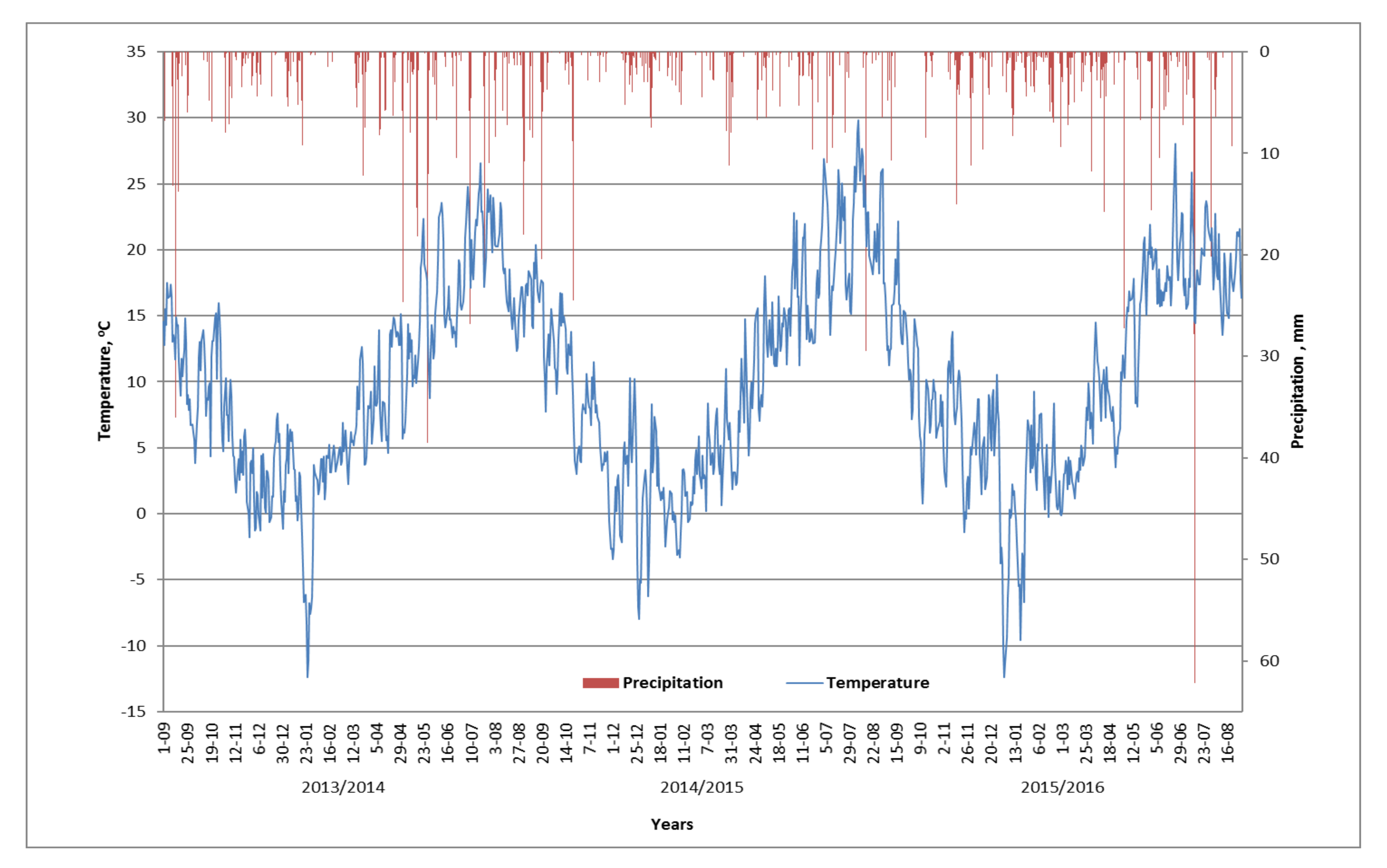
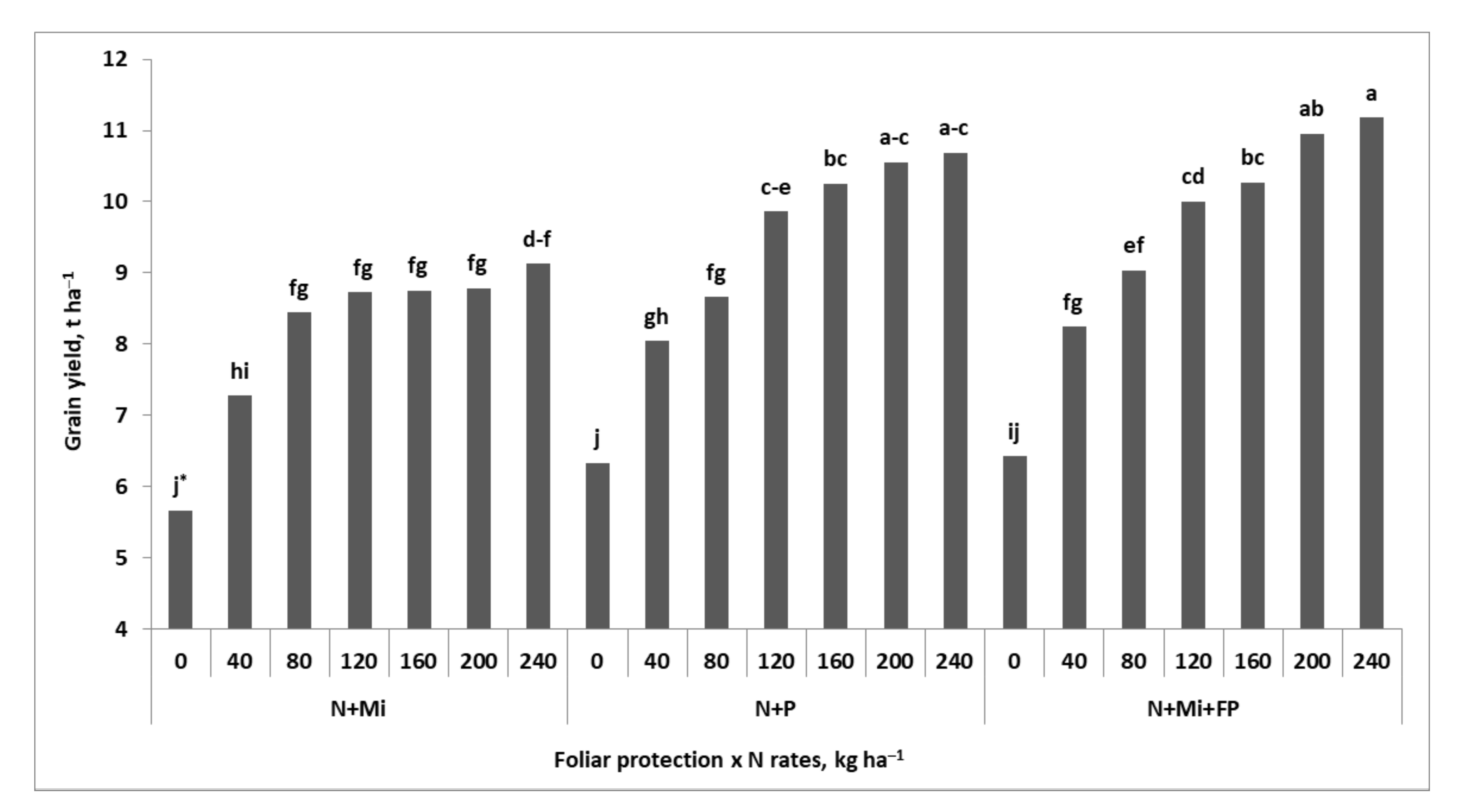
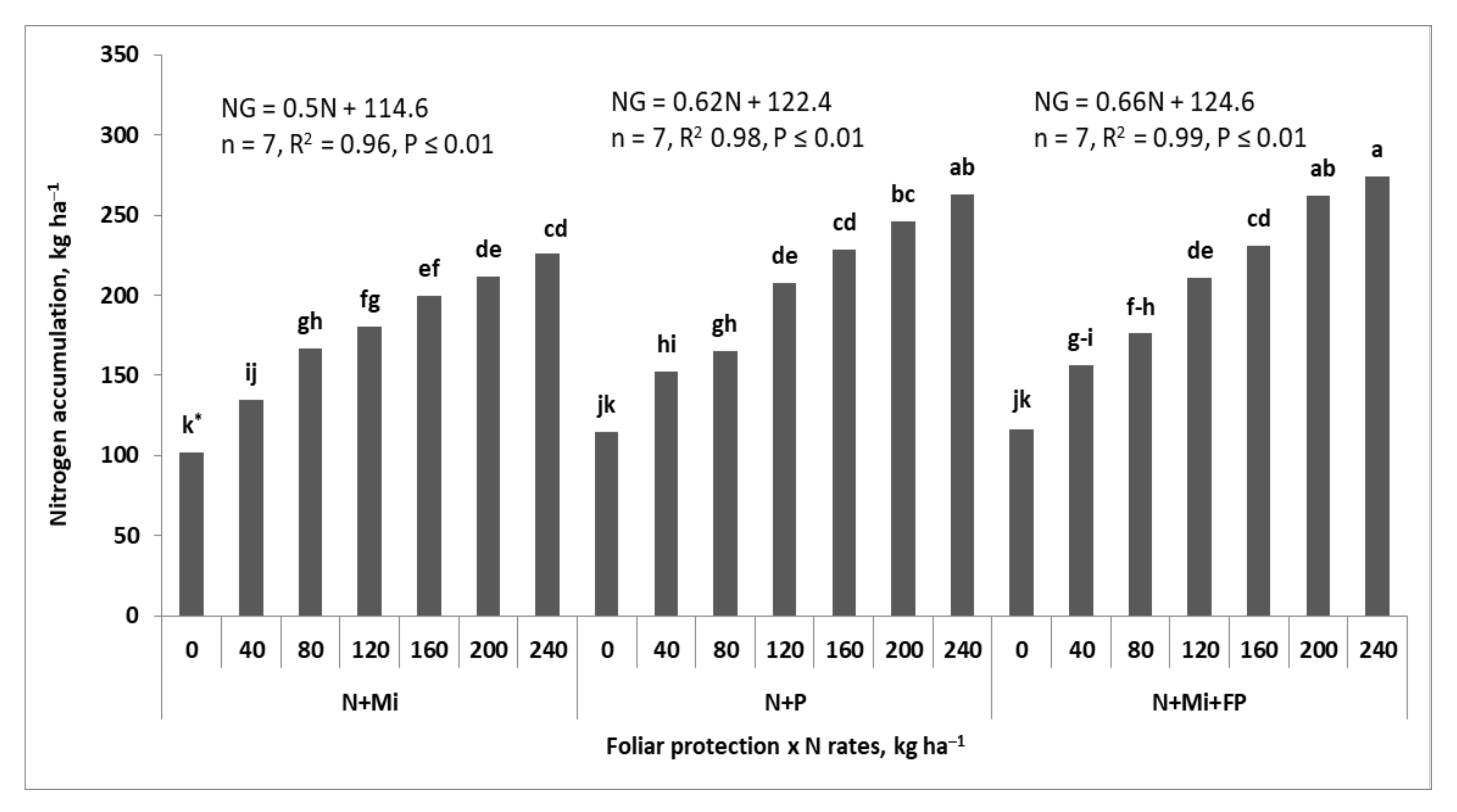


| Soil, cm | pH | Corg | P | K | Mg | Ca | Cu | Mn | Zn | Fe | Nmin |
|---|---|---|---|---|---|---|---|---|---|---|---|
| % | mg kg−1 | kg ha−1 | |||||||||
| 2013/2014 | |||||||||||
| 0–30 | 6.9 | 1.3 | 234 VH 5 | 231 M | 105 VL | 988 L | 0.4 L | 27.2 L | 3.6 M | 536 H | 86.4 |
| 30–60 | 6.7 | 1.1 | 234 VH | 237 M | 103 VL | 876 L | 0.4 L | 25.7 L | 3.5 M | 541 H | |
| 2014/2015 | |||||||||||
| 0–30 | 7.1 | 2.2 | 185 H | 185 M | 165 M | 2045 M | 3.5 M | 85.5 M | 6.3 H | 268 M | 129 |
| 30–60 | 7.2 | 2.1 | 161 H | 157 L | 155 L | 2063 M | 3.5 M | 93.8 M | 5.6 H | 26 9M | |
| 2015/2016 | |||||||||||
| 0–30 | 6.6 | 1.6 | 202 VH | 281 M | 165 M | 1480 L | 2.8 M | 61.9 M | 6.1 H | 347 M | 110 |
| 30–60 | 6.6 | 1.4 | 139 H | 222 M | 163 L | 1504 L | 2.5 M | 62.0 M | 3.7 M | 231 M | |
| Growing Season | March | April | May | June | July |
|---|---|---|---|---|---|
| 2013/2014 | 2.0 qw | 1.3 qd | 3.4 ew | 0.6 vd | 1.1 qd |
| 2014/2015 | 2.8 vw | 0.8 d | 0.6 vd | 0.7 vd | 0.7 vd |
| 2015/2016 | 4.3 ew | 1.7 qw | 1.2 qd | 0.7 vd | 2.2 w |
| Stage of Wheat Growth | Microelements | Fungicide |
|---|---|---|
| BBCH 30/31 | Cu + Mn → 60 + 140 g ha−1 | Capalo 337.5 SE → 1.5 dm3 ha−1 |
| BBCH 39 | Cu + Mn + Zn → 15 + 60 + 100 g ha−1 | Adexar Plus → 2 dm3 ha−1 |
| BBCH 65 | - | Osiris 65 EC → 2 dm3 ha−1 |
| Factor | Level of Factor | Degree of Freedom | GY 1 | SY | TB | HI | ED | GR | GD | TGW |
|---|---|---|---|---|---|---|---|---|---|---|
| t ha−1 | % | Ears m−2 | Grains Ear−1 | Grains m−2 | g | |||||
| Year (Y) | 2014 | 2 | 9.053 b | 9.085 b | 18.138 b | 50.3 a | 651.810 b | 31.2 a | 19.672 b | 46.1 c |
| 2015 | 11.036 a | 12.155 a | 23.191 a | 47.4 b | 710.762 a | 31.3 a | 22.142 a | 49.7 a | ||
| 2016 | 6.665 c | 10.044 c | 16.709 c | 39.8 c | 617.0 b | 22.5 b | 13.669 c | 48.6 b | ||
| P | *** | *** | *** | *** | *** | *** | *** | *** | ||
| Foliar Protection | N + Mi | 2 | 8.112 c | 10.160 | 18.272 b | 44.1 b | 646.7 | 27.1 b | 17.395 b | 46.4 c |
| (FP) | N + P | 9.199 b | 10.762 | 19.961 a | 45.9 a | 675.5 | 28.4 ab | 18.937 a | 48.7 b | |
| N + Mi + P | 9.443 a | 10.363 | 19.806 a | 47.6 a | 657.3 | 29.5 a | 19.151 a | 49.3 a | ||
| P | *** | ns | *** | *** | ns | * | *** | *** | ||
| Nitrogen | 0 | 6 | 6.141 f | 8.252 c | 14.393 d | 43.1 c | 552.7 c | 23.8 b | 12.917 f | 47.6 b |
| (N) | 40 | 7.853 e | 9.924 b | 17.777 c | 44.1 bc | 625.9 b | 26.6 ab | 16.379 d | 47.8 b | |
| 80 | 8.711 d | 10.717 ab | 19.428 b | 44.9 ab | 665.5 ab | 27.9 a | 18.181 c | 47.9 b | ||
| 120 | 9.528 c | 10.761 ab | 20.289 ab | 46.8 ab | 673.4 ab | 29.9 a | 19.804 b | 48.1 b | ||
| 160 | 9.759 bc | 10.993 ab | 20.752 a | 47.0 ab | 687.0 ab | 30.2 a | 20.183 ab | 48.3 ab | ||
| 200 | 10.100 ab | 11.109 ab | 21.209 a | 47.3 ab | 702.0 a | 30.0 a | 20.932 a | 48.3 ab | ||
| 240 | 10.333 a | 11.241 a | 21.574 a | 47.8 a | 712.5 a | 29.8 a | 21.063 a | 49.0 a | ||
| P | *** | *** | *** | *** | *** | *** | *** | *** | ||
| Source of variation for interactions | ||||||||||
| Y*FP | 4 | *** | ns | ns | ** | ns | ns | ** | *** | |
| Y*N | 12 | *** | ns | *** | ns | ns | ns | *** | *** | |
| FP*N | 12 | *** | ns | ns | ns | ns | ns | *** | *** | |
| Y*FP*N | 24 | ns | ns | ns | ns | ns | ns | ns | * | |
| Factor | Level of Factor | Degree of Freedom | NG 1 | Nr | NT | NHI | NUA | NJP-G | NJP-T |
|---|---|---|---|---|---|---|---|---|---|
| kg ha−1 | % | kg N t−1 TB | kg Grain kg−1 NG | kg TB kg−1 NT | |||||
| Year (Y) | 2014 | 2 | 179.5 b | 45.1 b | 224.6 b | 80.0 a | 24.6 c | 51.8 a | 41.5 a |
| 2015 | 231.0 a | 67.5 a | 298.6 a | 77.0 b | 26.6 b | 49.6 b | 38.1 b | ||
| 2016 | 164.4 c | 67.6 a | 232.0 b | 70.7 c | 34.6 a | 41.4 c | 29.3 c | ||
| P | *** | *** | *** | *** | *** | *** | *** | ||
| Foliar Protection | N + Mi | 2 | 174.4 c | 62.6 a | 237.0 b | 73.6 c | 29.7 a | 47.5 | 35.1 b |
| (FP) | N + P | 196.9 b | 60.4 ab | 257.3 a | 76.2 b | 28.3 b | 47.8 | 36.5 a | |
| N + Mi + P | 203.6 a | 57.2 b | 260.9 a | 77.9 a | 27.8 b | 47.6 | 37.2 a | ||
| P | *** | * | *** | *** | *** | ns | *** | ||
| Nitrogen | 0 | 6 | 111.1 g | 37.1 e | 148.2 g | 75.4 | 24.5 f | 55.4 a | 42.0 a |
| (N) | 40 | 147.7 f | 49.5 d | 197.2 f | 74.9 | 26.2 d | 52.7 ab | 39.8 b | |
| 80 | 169.4 e | 56.6 cd | 226.0 e | 75.0 | 26.8 cd | 51.1 b | 38.5 b | ||
| 120 | 199.6 d | 60.5 bc | 260.1 d | 76.6 | 28.1 c | 47.6 c | 36.6 c | ||
| 160 | 219.5 c | 69.8 ab | 289.4 c | 75.8 | 30.4 b | 44.3 d | 33.6 d | ||
| 200 | 239.8 b | 71.4 a | 311.2 b | 76.7 | 31.7 ab | 41.9 e | 32.3 de | ||
| 240 | 254.3 a | 75.9 a | 330.1 a | 76.8 | 32.6 a | 40.5 f | 31.2 e | ||
| P | *** | *** | *** | ns | *** | *** | *** | ||
| Source of variation for interactions | |||||||||
| Y*FP | 4 | ** | ns | ns | ns | ** | ns | ** | |
| Y*N | 12 | *** | ns | *** | ns | ns | *** | *** | |
| FP*N | 12 | *** | ns | ns | * | ns | ns | ns | |
| Y*FP*N | 24 | ns | ns | ns | ns | ns | ns | ns | |
| Factor | Level of Factor | Degree of Freedom | PFP-N | NAE | R-N | N-PhE |
|---|---|---|---|---|---|---|
| kg Grain kg Nf | % | kg Grain kg−1 NNT | ||||
| Year (Y) | 2014 | 2 | 92.8 b | 27.8 b | 86.0 b | 31.5 a |
| 2015 | 112.1 a | 41.6 a | 129.3 a | 31.4 a | ||
| 2016 | 64.7 c | 12.4 c | 65.6 c | 19.9 b | ||
| P | *** | *** | *** | *** | ||
| Foliar Protection | N + Mi | 2 | 82.8 b | 25.0 a | 94.4 | 24.6 b |
| (FP) | N + P | 92.1 a | 27.5 ab | 89.2 | 29.4 a | |
| N + Mi + P | 94.6 a | 29.3 a | 97.4 | 28.8 a | ||
| P | *** | * | ns | *** | ||
| Nitrogen | 40 | 6 | 196.3 a | 43.3 a | 126.5 a | 31.5 a |
| (N) | 80 | 108.9 b | 32.1 b | 96.7 b | 33.5 a | |
| 120 | 79.4 c | 28.2 bc | 93.2 b | 29.8 a | ||
| 160 | 61.0 d | 22.6 cd | 88.2 b | 24.9 b | ||
| 200 | 50.5 e | 19.8 d | 81.5 b | 23.4 b | ||
| 240 | 43.1 f | 17.5 d | 75.8 b | 22.5 b | ||
| P | *** | *** | *** | *** | ||
| Source of variation for interactions | ||||||
| Y*FP | 4 | *** | *** | * | ns | |
| Y*N | 12 | *** | *** | * | *** | |
| FP*N | 12 | * | ns | ns | ns | |
| Y*FP*N | 24 | ns | ns | ns | ns | |
Publisher’s Note: MDPI stays neutral with regard to jurisdictional claims in published maps and institutional affiliations. |
© 2022 by the authors. Licensee MDPI, Basel, Switzerland. This article is an open access article distributed under the terms and conditions of the Creative Commons Attribution (CC BY) license (https://creativecommons.org/licenses/by/4.0/).
Share and Cite
Szczepaniak, W.; Nowicki, B.; Bełka, D.; Kazimierowicz, A.; Kulwicki, M.; Grzebisz, W. Effect of Foliar Application of Micronutrients and Fungicides on the Nitrogen Use Efficiency in Winter Wheat. Agronomy 2022, 12, 257. https://doi.org/10.3390/agronomy12020257
Szczepaniak W, Nowicki B, Bełka D, Kazimierowicz A, Kulwicki M, Grzebisz W. Effect of Foliar Application of Micronutrients and Fungicides on the Nitrogen Use Efficiency in Winter Wheat. Agronomy. 2022; 12(2):257. https://doi.org/10.3390/agronomy12020257
Chicago/Turabian StyleSzczepaniak, Witold, Bartłomiej Nowicki, Dagmara Bełka, Adrian Kazimierowicz, Michał Kulwicki, and Witold Grzebisz. 2022. "Effect of Foliar Application of Micronutrients and Fungicides on the Nitrogen Use Efficiency in Winter Wheat" Agronomy 12, no. 2: 257. https://doi.org/10.3390/agronomy12020257





